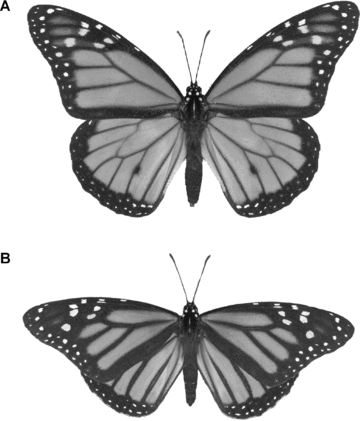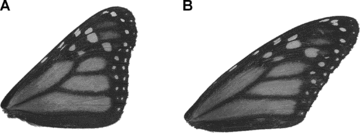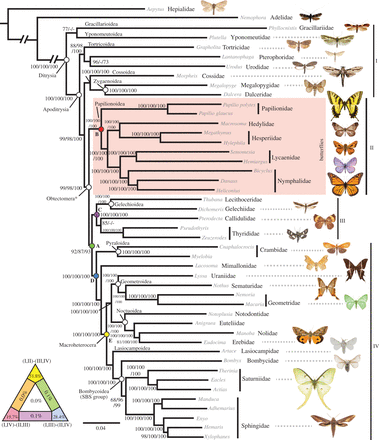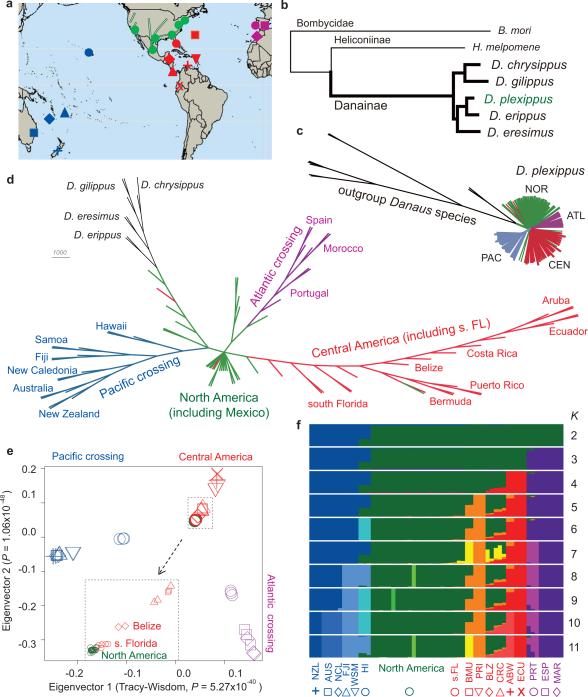Evolution and Migration
Wing Shape and Genetics

It has been found in a study done by Altizer and Davis that migratory behaviors in monarch butterflies can be correlated with the size of their forewings. The Eastern population which flies the farthest has the “largest and most elongated forewings” with the roundness and size of the forewing consistently decreasing among other populations that fly shorter distances. Puerto Rican and Costa Rican monarchs (non-migratory populations) have the shortest forewings. These phenotypic variations within the populations are maintained within captive-bred monarch populations, leading to a conclusion that there is a genetic basis leading to wing phenotypes and that this is an evolutionary adaptation to long-distance migration. Altizer and Davis proceed to imply that the variability of wing traits between populations might have implications on the ongoing conservation efforts of wild monarchs.

Citations:
Altizer, S. and Davis, A. K. (2010), POPULATIONS OF MONARCH BUTTERFLIES WITH DIFFERENT MIGRATORY BEHAVIORS SHOW DIVERGENCE IN WING MORPHOLOGY. Evolution, 64: 1018–1028. doi:10.1111/j.1558-5646.2009.00946.x
Genome of the Monarch
Where did the monarch’s migratory behavior come from? It is difficult to pinpoint the exact origins of migratory behavior, and so it is not entirely clear where the migratory behavior of the monarch came from, but there are many clues that narrow down the answer. Recent major discoveries in the genome of the monarch provide insight on the dispersal of monarchs from North America1,2 and how migration has shaped the selection pressures on monarchs historically, though the genetic basis and origin of monarch migratory behavior still requires more research before definitive conclusions can be reached.
 4
4
The order Lepidoptera, to which monarch butterflies and most butterflies and moths belong, has been found to be one of the fastest, if not the fastest, evolving insect orders examined.1 The development of migratory behavior has significant advantages and disadvantages yet it can be found in many different members of the order Lepidoptera and in other orders within the class Insecta. The adaptations for migration in insects have been theorized to be more advantageous for species that are subject to intense changes in resource availability due to the change in seasons, though others make the case that migratory adaptation is more likely to come from species living in isolated pockets of suitable environments.3 Both of these conditions are true of monarchs, who have non-migratory pockets in places like Florida and many populations of migratory monarchs across North America, leaving the reasoning unclear. Many other species within the order exhibit massive migratory behavior, including over 250 species in India that include species in the families Nymphalidae, to which monarchs belong, and Pieridae, which belongs to the same superfamily, Papilionoidea.5 Many different species exhibit migration, across many different orders of insects which makes the origin of the monarch’s specific type of migration difficult to pinpoint and differentiate even among the same family.
 2
2
The most complete and compelling information on the origin of monarch migration can be derived from genetic study of the monarch genome compared across the world and to its close relative D. erippus. Pictured above is a figure demonstrating the proposed dispersal of monarch butterflies from North America, which relies on the founder effect, the lesser genetic diversity found in populations that split off from the original population to colonize new territory. The data strongly suggests that monarch butterflies originated in North America and colonized the other parts of the world they appear in today. This makes the examination of the southern migration, typical of the North American variety of monarch, an excellent avenue of investigation for determining the origin of monarch migratory behavior. Further comparison of the genome of the monarch, D. plexippus and D. erippus strongly suggests that the common ancestor of the two experienced selection for migratory behavior and the development of more efficient flight muscles, strongly suggesting that it was migratory.2
These genetic findings would mean the origin of the monarch’s migratory behavior comes from its ancestors and many further comparisons of genomes will have to be made to determine at what point the selection for the monarch’s type of migration began and how it was changed in subsequent generation and species divergences.
Citations:
-
Zhan S, Merlin C, Boore JL, Reppert SM. The monarch butterfly genome yields insights into long-distance migration. Cell. 2011;147(5):1171–85. Epub 2011/11/29. doi: 10.1016/j.cell.2011.09.052 pmid:22118469; PubMed Central PMCID: PMC3225893.
-
Zhan, S., Zhang, W., Niitepõld, K., Hsu, J., Haeger, J., & Zalucki, M. et al. (2014). The genetics of monarch butterfly migration and warning colouration. Nature, 514(7522), 317-321. doi:10.1038/nature13812
-
Southwood, T.R.E. (1962). "Migration of terrestrial arthropods in relation to habitat". Biological Review. 37: 171–214. doi:10.1111/j.1469-185x.1962.tb01609.x
-
Kawahara, A. & Breinholt, J. (2014). Phylogenomics provides strong evidence for relationships of butterflies and moths. Proceedings Of The Royal Society B: Biological Sciences, 281(1788), 20140970-20140970. doi:10.1098/rspb.2014.0970
-
Senthilmurugan B. Mukurthi National Park: A migratory route for butterflies. (Aug 2005) J. Bombay. Nat. Hist. Soc. 102 (2): pp 241-242.